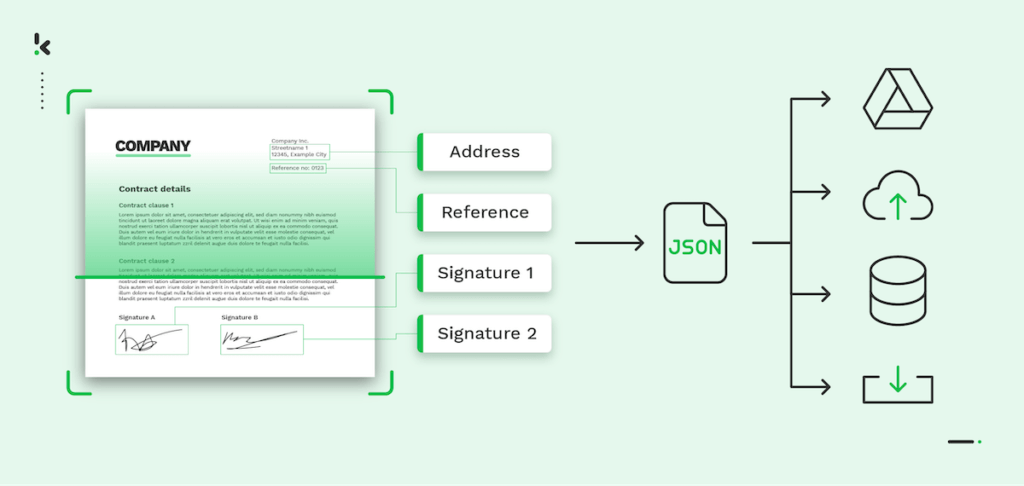

Contracts are the backbone of any business relationship, especially for your in-house legal teams and lawyers responsible for managing them. From defining terms to safeguarding legal interests, they contain crucial data that drives day-to-day operations.
However, with the sheer volume of documents and contracts your legal teams can be faced with, it becomes essential to find the most efficient way to quickly and accurately extract information. This is where automated contract data extraction comes into play, helping your legal teams streamline workflows and mitigate risks. But how do you make this process more efficient?
In this blog, we’ll explore what automated data extraction is, why it’s a game-changer for legal document management, and how you can implement it to improve accuracy and reduce manual work. Let’s dive in!
What is Contract Data Extraction?
Contract data extraction refers to the process of identifying and retrieving key information from contracts, such as key dates, terms, and clauses for informed decision-making. This data can be stored and easily retrieved.
This is typically done either by manually reviewing contracts to identify important metadata and recording it as needed. Alternatively, automation can be used through a document processing platform that offers data extraction services.
Why is Contract Data Extraction Important?
Aside from the benefits of efficiency and productivity, extracting key contract metadata is essential for your business in more ways than you can think. Here are 3 important reasons:
- Risk Mitigation: Contracts often include clauses and obligations that, if missed, can lead to costly disputes. By extracting critical data like deadlines and responsibilities, businesses can stay compliant and avoid legal risks.
- Optimizing Workflows: Many organizations still manage contracts manually, leading to inefficiencies. Businesses can streamline contract management processes by automating contract data extraction, allowing teams to focus on higher-value tasks.
- Decision-Making: Data extracted from contracts gives decision-makers a clearer view of contractual obligations, which can influence negotiations, renewals, and partnerships.
Contract Data Extraction Use Cases
- Legal Departments: Reduce the time spent on contract review and analysis by automatically pulling key terms, compliance data, and obligations, freeing up time for high-level strategy.
- Procurement Teams: Easily extract pricing terms, payment schedules, and supplier obligations, making it easier to compare vendor agreements and ensure favorable terms.
- Sales Teams: Extract renewal dates, commission structures, and termination clauses to manage relationships and avoid revenue leakage.
The risks associated with inaccurate data extraction can be dire for your business. So let’s dive into what exactly the process can look like using our solution as an example.
How to Automate Data Extraction from Contracts
Klippa DocHorizon is an Intelligent Document Processing (IDP) platform that enables you to automate all kinds of document workflows, from contract data extraction to conversion. In just a few steps, you can configure workflows to extract key details like contract dates, parties, and obligations. And the best part? You can try it out for free! Want in?
Step 1: Sign Up to the Platform
The first thing to do is to sign up to the DocHorizon Platform. Simply fill in your name and email address to get started. You will instantly receive a free credit of €25 to test all the capabilities of the platform for yourself.
Step 2: Ingest Contracts
If your contracts are digitized then you are good to go, if not then you can scan your documents with our mobile scanning SDK or upload them to the platform in formats like JPG, JPEG, PNG, PDF, DOC, DOCX, XLSX, HEIC, and webp.
Once you have your contract documents ready, you can select your input source. For this example, we’re going to show how to select a Google Drive folder as your input location.
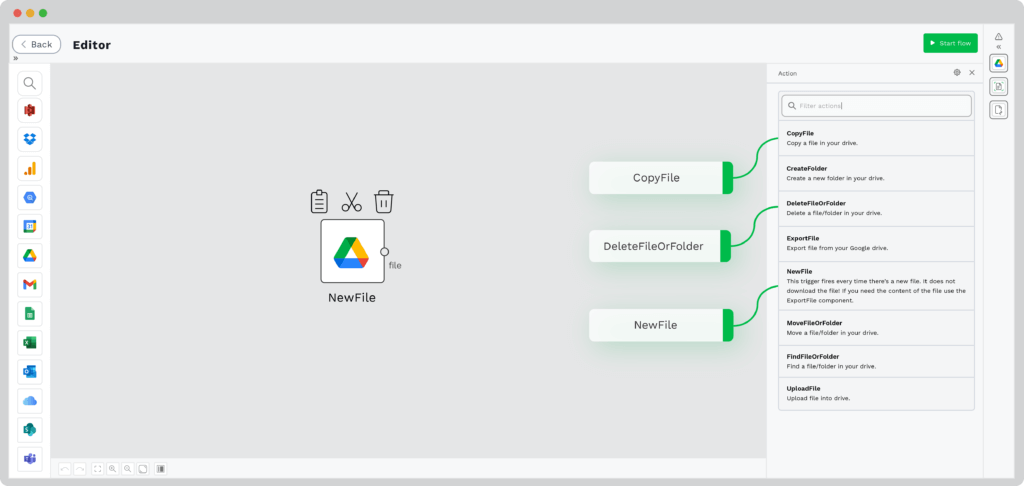

Step 3: Identify Key Metadata
As there are different types of contracts containing varying levels of details and information it would be difficult to have a standard set of instructions for each of them. That’s why we’ve created a Prompt Builder.
Within the Prompt Builder interface, you can select an existing template to extract data from your chosen document, create your own template from scratch, or simply ask the Prompt Builder to scan the document and develop prompts based on what it has reviewed. For instructions on how to do it, we have a video explaining how it works.
Step 4: Extract Key Contract Metadata
At this stage, the builder is able to extract the data you need based on your previously stated prompts (step 3). Select “Capture document with the prompt builder” as your Document Capture option and connect the template you’ve created in step 3.
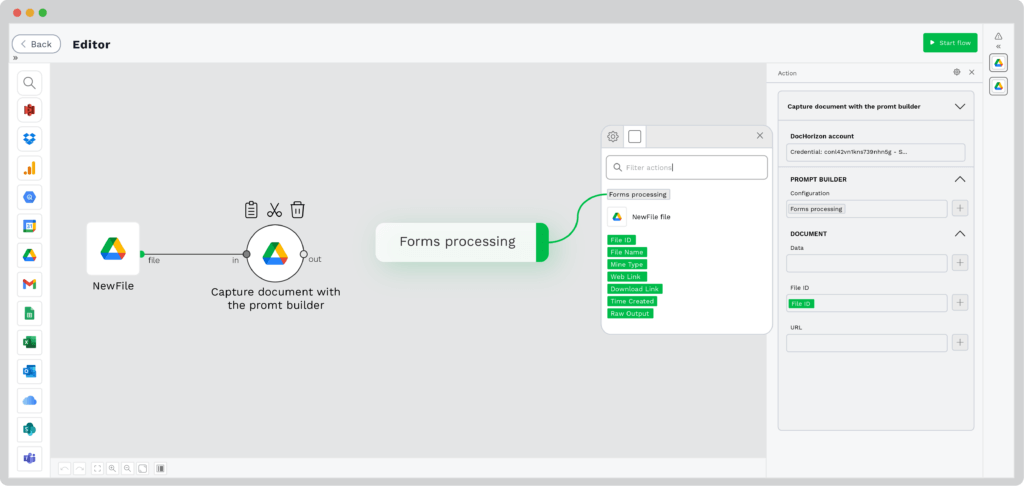

Step 5: Convert JSON Output to Your Desired Format
Our contract data extraction output is in JSON format (by default). However, if you need to this extracted data in another format or need to send it elsewhere in a different format, you can easily convert it to various structured formats like XLSX, CSV, HTML, and others. For instance, XLSX is suitable if you want to compile the companies you have signed contracts with and their expiration dates in a spreadsheet for a clear overview.
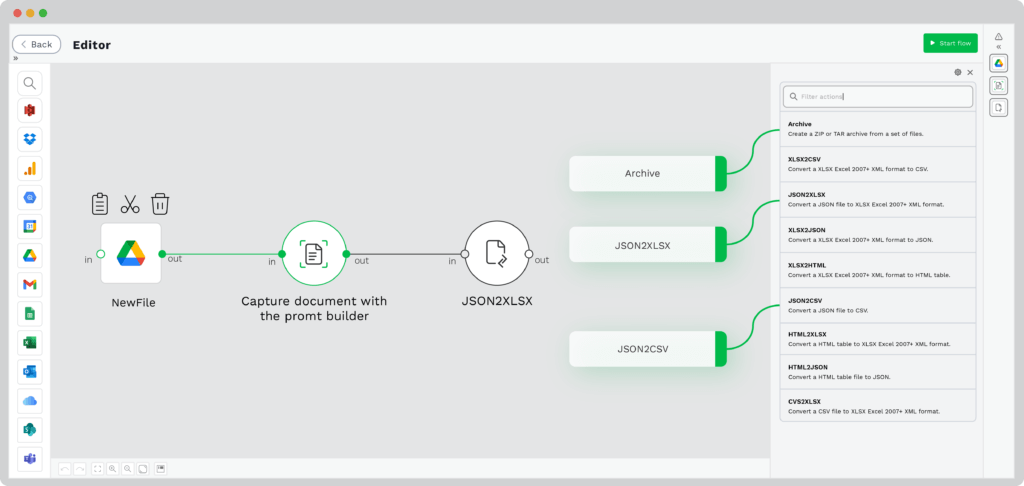

Step 6: Select Your Output Destination
Great! Your key data has been converted, and it’s now ready to export directly to your desired destination. This can be an Excel spreadsheet, Google Drive, SharePoint, or somewhere else.
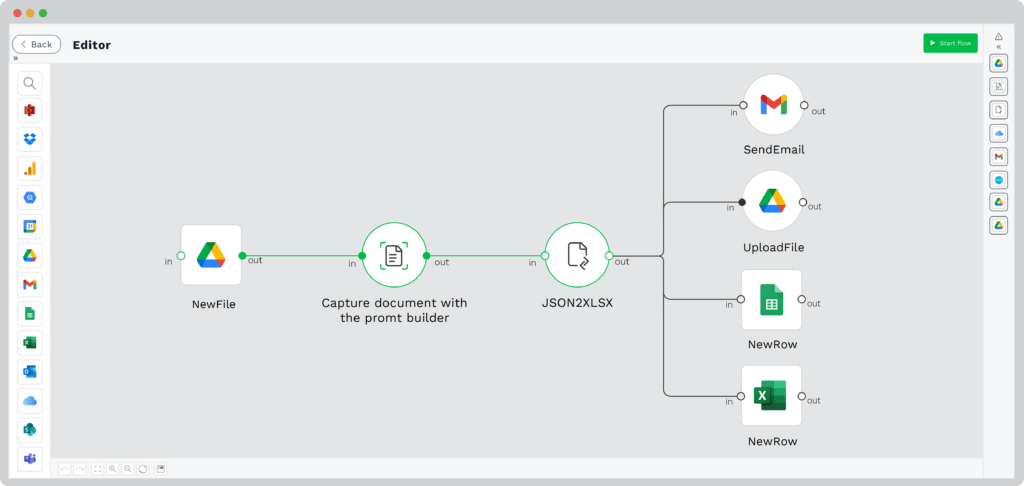

This is great as it allows you to begin organizing, analyzing, and storing the extracted data efficiently.
And thats it! In just a few simple steps you can automate your contract workflows and enjoy the benefits and convenience of automation. The next section will summarize some of the key data that can be extracted from contracts with automation.
What Types of Contract Metadata Can Be Captured?
Depending on your needs, a range of key metadata can be captured and extracted from contracts. The following are the six of the most critical types of metadata that our solution can extract:
1. Parties Involved
This is standard information that every contract should contain indicating the parties involved and details about their roles in the contract. These typically include:
- Business entity name
- Counterparty name
- Business and counterparty roles
- Contact information
- Signatory details
2. Contract Lifecycle Data
This involves standard information on the lifecycle and duration of the contract and the agreement between the parties involved. These usually include:
- Contract start date
- Contract end date
- Renewal dates
- Payment due dates
- Performance or delivery deadlines
3. Payment Terms
This information covers the financial terms information agreed upon by the parties involved and dictated in the contract. These typically include:
- Payment schedule (e.g., monthly, quarterly)
- Payment amounts
- Penalties for late payments
- Discounts or rebates
- Currency type
4. Liability and Indemnity
This is standard information in a contract that indemnifies the parties involved in the contracts, mitigating risks for the future. This usually includes:
- Grounds for termination
- Notice period required for termination
- Penalties for early termination
- Auto-renewal termination window
- Conditions for triggering termination
5. Obligations and Deliverables
This data covers the specific obligations each party is expected to reach. This can include:
- Deliverables
- Performance metrics
- Reporting obligations
- Deadlines for completion of obligations
6. Dispute resolution
Probably the most important in terms of security, this data covers everything relevant for dispute resolution is critical for managing risk and compliance. This usually includes:
- Governing law
- Jurisdiction
Now as you can see these are all important pieces of information that can have far-reaching consequences if not properly captured and recorded accurately. Using automated contract extraction tools, like Klippa DocHorizon, can help make the process as secure and efficient as possible.
Automate Contract Data Extraction with Klippa
Klippa DocHorizon is an ISO-certified and GDPR-compliant platform, allowing you to automate any of your document workflows, securely and reliably. With our contract data extraction solution, you get to:
- Create custom document workflows, fully taking control over how you handle your contract data. Define your input and output sources and connect our software with any of your existing systems (50+ integrations out-of-the-box).
- Embrace up to 99% data extraction accuracy and automatically extract all relevant data from your contracts without relying on manual data entry. Get precise & actionable data for informed decision-making.
- Improve data management as automated processing ensures better data organization, making it easier to search, retrieve, and analyze information.
- Enable global reach and process contracts from partners across the world since Klippa DocHorizon supports 100+ languages and various document types.
- Scale your business with automation in your document workflows. Klippa’s bulk uploading capabilities allow you to process multiple contracts at once, ensuring that you can easily handle your workload even when the business grows.
Automating contract data extraction has never been easier with Klippa DocHorizon! You can reevaluate and focus your resources on the things that matter most and eliminate manual inefficient processes. Contact our experts for additional information or book a free demo down below!